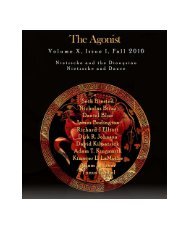Volume XII, Issue II, Spring 2019
You also want an ePaper? Increase the reach of your titles
YUMPU automatically turns print PDFs into web optimized ePapers that Google loves.
PETER S. GROFF<br />
from the “overshadowing” of Mary in the Annunciation to the darkness<br />
associated with God in Torahic theophanies and mystical texts (a function,<br />
ultimately, of God’s brilliant ontological radiance). Figuring most prominently in<br />
this discussion, however, is Jung’s archetypal notion of the shadow as the ‘dark’<br />
aspect of one’s self: the seemingly inferior, worthless, repressed or rejected<br />
characteristics that one cannot acknowledge or affirm, and which consequently<br />
reemerge as projected demonizations of the other. While Jung identifies in<br />
Nietzsche’s thought (as well as Freud’s) a refreshing willingness to recognize the<br />
“black substance” out of which all radiant things must necessarily emerge, he<br />
suggests that Zarathustra struggles to affirm his own shadow and thus repeatedly<br />
externalizes it (he interprets the parade of grotesque characters one finds there—<br />
the fire-dog, the Soothsayer, the Dwarf, the black snake, the Ape, the Ugliest Man,<br />
etc—as products of Zarathustra’s shadow-forming process). 3 And of course, one<br />
can see Nietzsche himself struggle with this through his doctrine of amor fati: “to<br />
see as beautiful what is necessary in things” (GS 276). On this account, as long as<br />
the self refuses to bring all parts of itself together, even its imperfections,<br />
shortcomings and humiliating inadequacies (“the enemy . . . in [one’s] own heart,”<br />
as Jung aptly puts it), it cannot achieve wholeness. Bishop clearly traces this idea<br />
back through German classicism to Neoplatonic aesthetics, emphasizing the<br />
essential connection between beauty and totality. Along the way, he examines<br />
some interesting subsidiary anticipations of Jung’s complementaristic vision, e.g.<br />
in the 16 th century alchemical text Rosarium philosophorum and Goethe’s pivotal<br />
poem “Blessed Yearning” (Selige Sehnsucht).<br />
Taken as a whole, this first lengthy chapter is a remarkable display of scholarly<br />
attentiveness and crackles with suggestive associations. Yet one can’t help but<br />
wonder what the punchline is. Bishop points out in the conclusion that<br />
“Nietzsche’s imagery in ‘On the Blissful Islands’ is extraordinarily rich in its<br />
intertextual and iconographic references and there are enormous associations at<br />
play when we read that the Superman came to Zarathustra as a shadow” (62). Surely<br />
this has been well demonstrated, but the original question hasn’t ultimately been<br />
addressed: why does the beauty of the Superman come to Zarathustra as a shadow?<br />
3 Jung is more circumspect about identifying the Shadow himself (IV.9) as one of<br />
Zarathustra’s shadows. Although Bishop offers a lengthy Jungian analysis of the Ugliest<br />
Man (Z IV.7), he does not have much to say here about the last human being (Z P.4) or<br />
the small human being (Z <strong>II</strong>I.13.2), but affirmation of such realities would presumably<br />
be a necessary condition for the “completion” of the human being as Übermensch (see<br />
Bishop, 10-13).<br />
55









